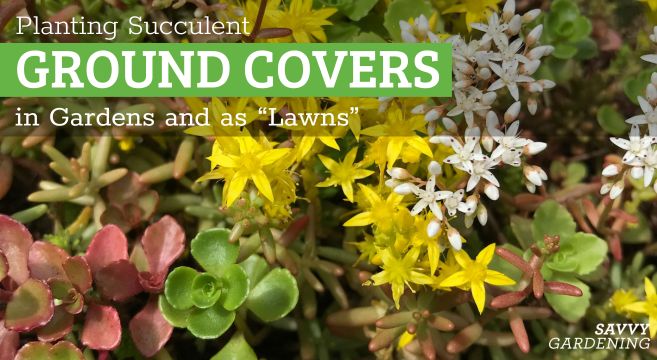This post may contain affiliate links. If you make a purchase through links on our site, we may earn a commission.
One of my favorite plants in my garden is a variety of Delosperma called ‘Fire Spinner’. This ground cover has spread around an otherwise exposed area of my front garden and features vibrant fuchsia and orange flowers. A succulent ground cover is a great option for a sunny, dry area of the garden. In this article, I’m going to share why succulents make good ground covers, some favorites, as well as some ideas on where to plant them and why.
Why low-growing succulents make good ground covers
There are some succulents that make great mounding garden plants (like ‘Autumn Joy’ sedum), while others are very low growing, making them perfect ground cover options.
Here are some reasons to choose a succulent ground cover:
- They are low-maintenance plants
- Most are drought tolerant and will thrive in a garden that gets full sun
- They don’t need much soil to take root, so they’re great options for rock gardens
- Succulents are easy to propagate, so you can make more from a simple stem cutting
- They provide winter interest
- Succulents will help to keep weeds at bay in a blank area of the garden
- In a sloping landscape, plants can provide some erosion control
- Succulents can take the heat
- Sedum flowers attract pollinators, from bees and butterflies to hummingbirds
- Plants will go dormant in the winter, providing winter interest

Choosing a succulent ground cover
If you’re hoping for perennial ground cover, check the plant tag closely to make sure it won’t just be a short-lived annual. You want to make sure it will survive in your hardiness zone (USDA, Canada, etc.). Some succulent ground covers are used to tropical conditions, so they don’t like frost, never mind an entire cold winter potentially covered in snow.
Look for indications of the mature size of the plant, including the height and how much it will spread.
It’s important to note that before you plant any sort of spreading ground cover plant, you make sure it’s not invasive to your region. A quick online search with the word “invasive” will help determine whether you should plant it or not.
Where to plant succulent ground cover plants
Succulent ground covers are great for areas of the garden where you have a flat patch in front of plants with more height. Plant a ground cover that will fill into that space, providing visual interest, but without hiding any of the plants behind it.
These ground covers are also ideal for rock gardens or sloped gardens. Many of them will trail over rocks or other garden edges, filling in an empty space, while also holding the soil in place.

There are also a lot of great succulents that are worth investigating if you’re looking into planting a green roof. They are low-growing, lightweight, and will thrive in the drought-tolerant conditions of a roof setting.
Another option to consider is a succulent ground cover “lawn.” When I was writing Gardening Your Front Yard, I was trying to think of an interesting way to plant up a tiny strip of front yard garden in an urban area. A lightbulb went off when I stopped by the Sedum Master booth at a trade show. The company makes sedum mats for green roof applications. The best way I can describe sedum mats is a rectangle planted up with a dozen or so varieties of sedum. You lay out these mats as you would a carpet. And you can trim them accordingly to suit the space.

A few interesting succulent ground cover options
A lot of succulent ground cover plants look so similar, it’s hard to tell them apart. I’ve gathered a few favorites here, but check out what your local nursery offers and you may discover an amazing, new-to-you succulent ground cover that’s perfect for your garden.
Delosperma
Native to the coast of South Africa, Delosperma is also commonly called an ice plant (though that name is also given to the approximately 1,800 species in the same family, including Drosanthemum speciosum or Royal Dewflower). The aforementioned ‘Fire Spinner’ was my introduction to Delosperma and since then I’ve planted ‘Ocean Sunset Orange Glow’. What’s interesting about these plants is they are nyctinastic, which means the flowers close up tight for the night—or even on a cloudy day. But during a sunny day, they open to reveal their vibrant, interesting flowers, making them “open for business” for bees and other pollinators.

Hens and chicks
Members of the stonecrop family (Crassulaceae), hens and chicks aka Sempervivum thrive in dry soils and don’t mind the heat, but are hardy between -40°F to -30°F (-40°C to -34.4°C). They’ll slowly spread outward, forming offsets from the main rosette. I’ve written about hens and chicks here.
Sedum ‘Ellacombianum’
I love the starbursts of small yellow flowers on Sedum ‘Ellacombianum’. They will bloom right through the summer into fall, attracting a variety of pollinators. The plant doesn’t mind a bit of partial shade. And the foliage also provides fall and winter interest. It is similar to Orange stonecrop, but the green leaves are longer and narrower.

Sedum ‘Spurium’
There are a few different cultivars of Sedum ‘Spurium’. I’m most familiar with ‘Dragon’s blood’, with its red-tinged edges, because it was in my mom’s front yard garden growing up. It is a very common sedum found in rock gardens. Sedum Spurium is also called Caucasian Stonecrop. It’s drought tolerant, doesn’t mind poor soils, and spreads nicely throughout a garden.





Leave a Reply